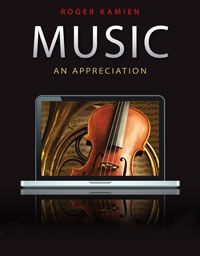
Music: An Appreciation, 10th Edition (Kamien)Chapter 7: KeyInteractive ChapterELEMENTS OF MUSIC: KEYPractically all familiar melodies are built around a central tone. The other tones of the melody gravitate toward this central one. Since the central tone is especially stable and restful, a melody usually ends on it. To feel the gravitational pull of a central tone, sing America and stop after the next-to-last word, freedom; then, after a few seconds, sing the ending tone of ring. You probably felt uneasy until you supplied the last tone. This central tone is the keynote, or tonic, of the melody. When a piece is in the key of C, for example, C is the keynote, or tonic. The keynote can also be E, or A, or any of the twelve tones that fill the octave in western music. Key involves not only a central tone but also a central scale and chord. A piece in the key of C has a basic scale, do-re-mi-fa-sol-la-ti-do, with C as its do, or tonic. And the basic chord of a piece in C is a tonic triad with C as its root, or bottom tone. As was noted in Section 6, the tonic triad is made up of do-mi-sol–the first, third, and fifth tones of the basic scale. Just as familiar melodies generally end on the keynote, compositions traditionally end with the restful tonic chord. Key, then, refers to the presence of a central note, scale, and chord within a piece. Another term for key is tonality. After 1900, some composers abandoned the traditional system, but even today much of the music we hear is built around a central tone, chord, and scale. Enter here to review the Elements of Music: KeyNote: If the Interactive Chapter does not open, you may have a pop-up blocker running. Please make sure to allow pop-ups for this website. Consult your browser's help documentation if you are unsure how to do this. |  |















